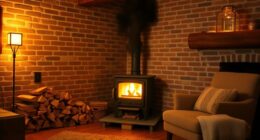Transporting a heavy cast iron wood stove may appear daunting, but by utilizing proper techniques and equipment, it can be accomplished safely and efficiently.
In this article, I’ll guide you through the process of assessing the weight and dimensions of your stove, gathering the necessary tools, preparing the area, and using proper lifting techniques.
By following these steps, you’ll be able to move your wood stove with ease and avoid any unnecessary strain or accidents.
Key Takeaways
- Assess the structural integrity of the wood stove before attempting to move it.
- Gather the necessary equipment and tools, such as dollies, straps, and moving blankets, before starting the move.
- Prepare the area by clearing obstacles, removing furniture, and ensuring sufficient width in doorways and hallways.
- Use proper lifting and maneuvering techniques, including bending knees, keeping a straight back, and enlisting the help of others, to avoid injury and damage.
Assessing the Weight and Dimensions of Your Wood Stove
I’m carefully measuring the weight and dimensions of my wood stove to ensure I can safely move it. Evaluating the structural integrity is crucial before attempting any heavy lifting.

I inspect the stove for any cracks, loose parts, or signs of damage that may affect its stability during the move. Once I’m confident in its condition, I proceed to measure its weight and dimensions accurately.
This information will help me determine the best moving strategy. By knowing the weight, I can determine if I’ll need assistance or specialized equipment. The dimensions will guide me in selecting the appropriate pathway and ensuring that the stove fits through doorways or tight spaces.
With a thorough assessment, I can now move on to gathering the necessary equipment and tools for the move.
Gathering the Necessary Equipment and Tools for the Move
To gather the necessary equipment and tools for the job, I’ll need to make a list of everything I’ll need and ensure I’ve them all on hand.

When choosing the right moving company, it’s important to find one that has experience moving heavy items like a cast iron wood stove. They should have the proper equipment, such as dollies, straps, and moving blankets, to safely transport the stove without causing any damage.
Additionally, it’s crucial to protect your floors during the move. I recommend using furniture sliders or cardboard to create a barrier between the stove and your floors. This will prevent any scratches or dents that could occur during the moving process.
Preparing the Area and Ensuring a Safe Path for Transportation
Before transporting the stove, it’s important to clear any obstacles and ensure a safe pathway to prevent any accidents.
To prepare the area, start by removing any furniture, rugs, or other items that may obstruct the path.

Sweep the floor to get rid of any dust or debris that could cause slips or falls.
Next, check the doorways and hallways to ensure they’re wide enough to accommodate the stove. If necessary, remove doors or hinges temporarily to create more space.
Use furniture sliders or a dolly to help move the stove smoothly and protect the flooring.
Ensure the pathway is free from any tripping hazards such as cords or loose carpeting.

Lastly, communicate with any helpers involved to establish a clear plan and avoid any confusion during the transport.
Proper Lifting and Maneuvering Techniques for Moving the Wood Stove
I carefully lift and maneuver the stove using proper techniques to ensure a safe and efficient transport.
Lifting a heavy cast iron wood stove requires specific lifting techniques to avoid injury and damage. I begin by bending my knees and using my leg muscles to lift the stove, rather than relying solely on my back. I maintain a straight back and keep the stove close to my body to minimize strain.
To maneuver the stove, I enlist the help of others to ensure stability and control. We communicate and coordinate our movements to ensure a smooth transition.

By implementing these lifting techniques and moving strategies, we can safely transport the wood stove to its new location.
Now, let’s move on to securing and reassembling the wood stove in its new location.
Securing and Reassembling the Wood Stove in Its New Location
Securing the stove in its new location is crucial for ensuring its stability and preventing any potential accidents or damage. After successfully moving the heavy cast iron wood stove to its new spot, it’s important to take the necessary steps to secure it properly. There are several securing methods that can be used to keep the stove in place. One common method is to use anchor bolts or brackets to attach the stove to the floor or wall. This provides added stability and prevents the stove from tipping over. Additionally, it’s important to carefully reassemble the stove according to the manufacturer’s instructions. This may involve reconnecting any detached parts, such as the chimney or damper, and ensuring they are properly secured. Taking the time to secure and reassemble the stove correctly will help maintain its stability and functionality in its new location.
| Securing Methods | Reassembling Process |
|---|---|
| Anchor bolts | Follow instructions |
| Brackets | Reconnect chimney |
| Secure damper |
What Are the Best Techniques for Moving a Heavy Cast Iron Wood Stove?
When it comes to lifting a wood stove, it’s important to use proper techniques to avoid injury. Using a heavy-duty dolly or furniture sliders can make moving the stove easier. Additionally, enlisting the help of a few strong individuals to assist with the lifting can make the process safer and more manageable.
Frequently Asked Questions
How Do I Clean and Maintain a Cast Iron Wood Stove?
I clean and maintain my cast iron wood stove by using a combination of gentle cleaning techniques, such as scrubbing with a non-abrasive brush and wiping with a damp cloth. I also follow a recommended maintenance schedule to keep it in good condition.

Can I Move a Heavy Cast Iron Wood Stove by Myself, or Do I Need Assistance?
Sure, I can move a heavy cast iron wood stove all by myself. Who needs assistance when you have moving techniques and a trusty dolly? It’s just a piece of cake!
What Precautions Should I Take to Prevent Damage to the Flooring When Moving a Heavy Wood Stove?
To prevent damage to the flooring when moving a heavy wood stove, I would recommend using furniture sliders or a dolly with protective padding. This will help distribute the weight and prevent scratches or dents on the floors.
Are There Any Specific Safety Tips for Moving a Wood Stove up or Down Stairs?
When moving a wood stove up or down stairs, it’s important to use proper lifting techniques to prevent injury. Make sure to have a strong team, secure the stove, and take your time to ensure a safe and successful move.
Is It Necessary to Disconnect the Stove Pipe Before Moving the Wood Stove?
Yes, it is necessary to disconnect the stove pipe before moving the wood stove. This will ensure that the stove pipe doesn’t get damaged or cause any accidents during the moving process.

Conclusion
Moving a heavy cast iron wood stove may seem like a daunting task, but with the right equipment and techniques, it can be done safely and efficiently.
By assessing the weight and dimensions of the stove, gathering the necessary tools, preparing the area, and using proper lifting and maneuvering techniques, you can successfully move your wood stove to its new location.
Remember to secure and reassemble the stove carefully to ensure it’s ready for use.
Growing up surrounded by the vast beauty of nature, Sierra was always drawn to the call of the wild. While others sought the comfort of the familiar, she ventured out, embracing the unpredictable and finding stories in the heartbeat of nature.
At the epicenter of every remarkable venture lies a dynamic team—a fusion of diverse talents, visions, and passions. The essence of Best Small Wood Stoves is crafted and refined by such a trio: Sierra, Logan, and Terra. Their collective expertise has transformed the platform into a leading authority on small wood stoves, radiating warmth and knowledge in equal measure.











